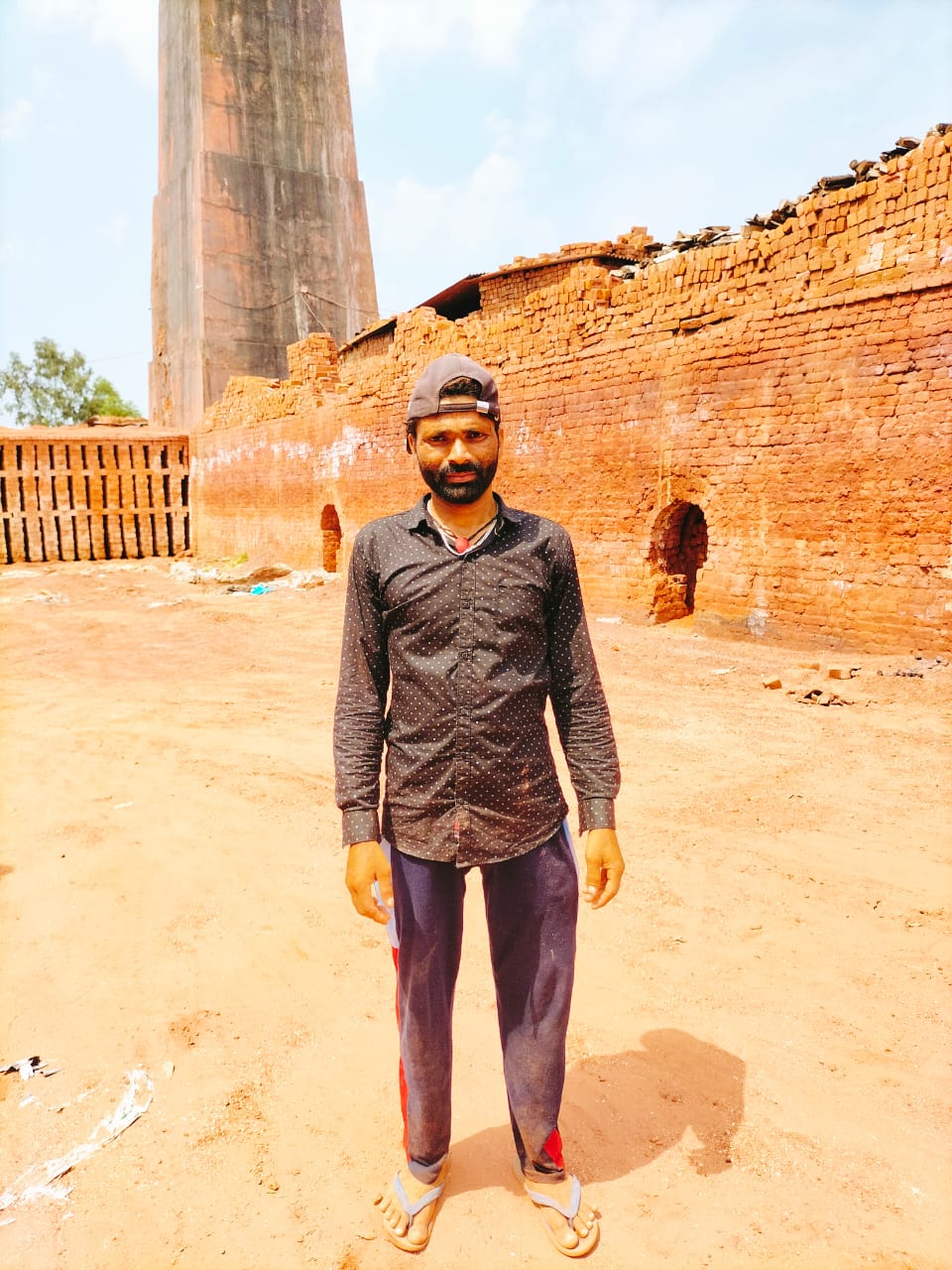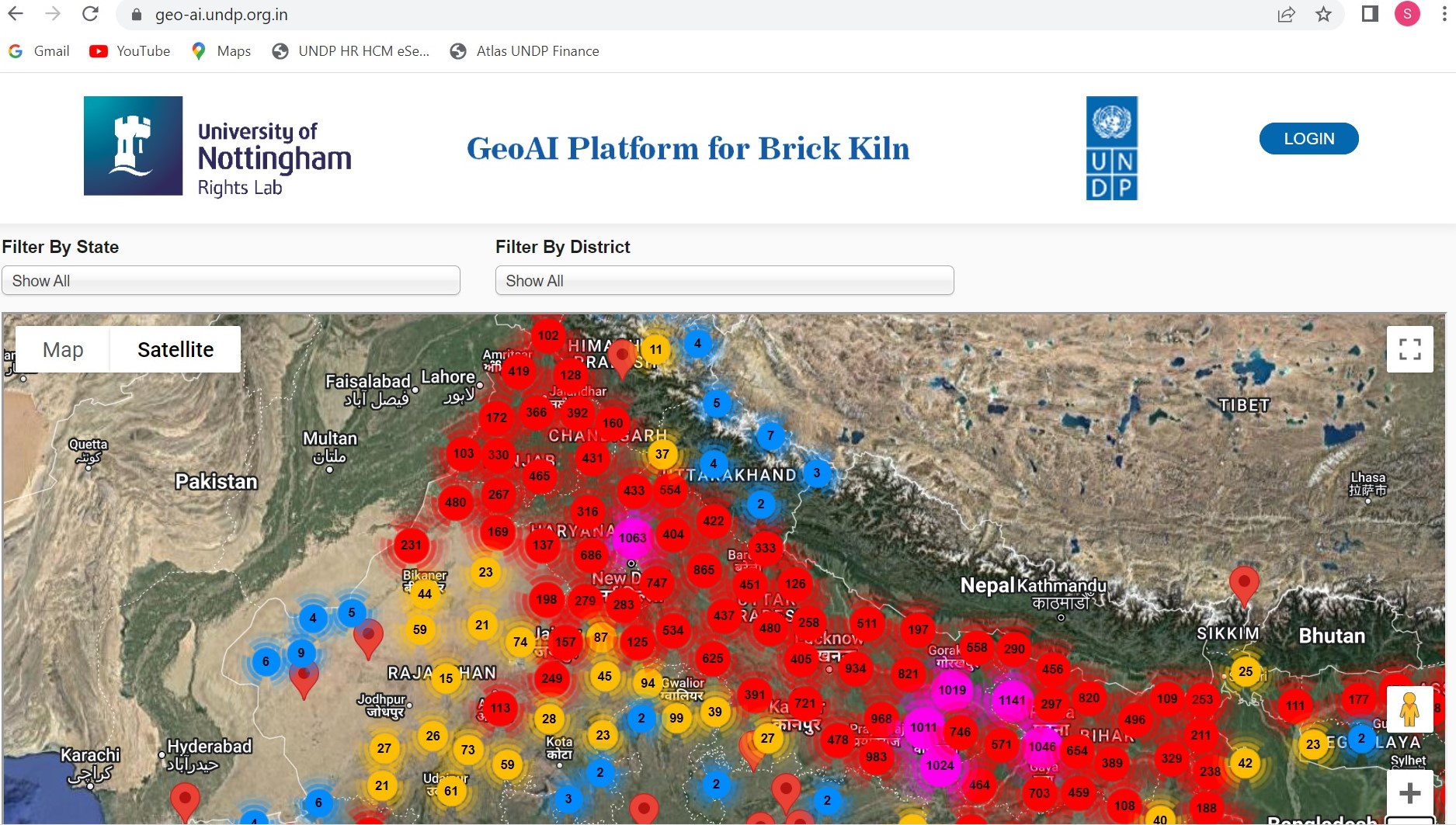GeoAI, a one-of-a-kind digital platform - supported by UNDP India, the University of Nottingham and State Pollution Control Boards - is using artificial intelligence and space tech to identify air pollution hotspots in India.
Tech for Clean Air and Blue Skies
September 7, 2022

More than 47,000 brick kilns across 12 states of India in the Indo-Gangetic plains are hot spots of air pollution
“As a brick kiln worker, my work starts at 4am and lasts at least 12 hours. While the work is tedious, what worries me more is my health. I am continuously exposed to dust and other pollutants, making respiratory diseases like asthma and tuberculosis common,” shares Mukesh Kumar, a brick-kiln worker in Punjab.

Brick kiln workers like Mukesh often work in unhealthy and unhygienic conditions.
Mukesh is one of 12 million brick kilns workers in India who usually work in unhealthy and unhygienic conditions. The brick manufacturing sector not only puts the workers at risk, but also contributes up to 14% of the total air pollution in India.
According to the latest Air Quality Life Index Annual Update, more than 510 million people (roughly 40% of India’s population) living in Northern India are exposed to pollution levels that regularly exceed those found elsewhere on Earth by order of magnitude.
Producing the burnt clay brick follows a primitive technology and this industry is third largest consumer of coal in India.
As part of efforts to safeguard the health of people and the planet, UNDP India, in partnership with Rights Lab at the University of Nottingham and state pollution control boards in India, has developed a first-of-its-kind technology platform, GeoAI, that solves the challenge of detection of sources of air pollution using satellite data.
This innovation is powered by artificial intelligence, citizen science, satellite imagery, and mobile technology, providing intelligence on the location and compliance of the brick kiln sector. It aims to improve the environmental compliance of the brick manufacturing industry in the country.
GeoAI has accurately mapped more than 47,000 brick kilns across 12 states of India in the Indo-Gangetic plains that are hot spots of air pollution.
India has an estimated number of 100,000 brick kilns or brick manufacturing units. The most widely used brick is the clay brick, there are still limited alternatives available
The regulatory challenge
"In Bihar, almost 4,000 out of 7,500 brick kilns have now switched to greener technology. But we face challenges in mapping the remaining brick kilns. Where are they located? What is the status of their environmental compliance? We would like a geo-referenced database of these brick kilns and overall compliance monitoring to support our regulatory governance activities,” shares Dr. Ashok Ghosh, Chairman, Bihar State Pollution Control Board.

Artificial Intelligence powered Object Detection Algorithms detecting exact location of brick kilns from satellite data and providing vital intelligence on environmental compliance of brick kilns.
The GeoAI platform is currently supporting the Governments of Bihar, Chhattisgarh, and Odisha to improve environmental compliance of brick manufacturing industries in the three states. For example, in Bihar, GeoAI has mapped more than 7,800 brick kilns in the state using satellite imagery, out of which 1,000 units were prioritized based on non-compliance scores of which more than 600 units were inspected and acted upon by the regulators, significantly reducing investments and time needed for verifying non-compliance in brick manufacturing sector.

The platform has user-friendly dashboards and tracking system on field inspection for environmental regulators. Image shows number of brick kilns mapped by AI algorithms in a geography, number of kilns assigned to field inspectors, number of kilns inspected .
“Every year, an estimated 7 million premature deaths can be attributed to air pollution in the world – making it one of the greatest environmental health risks of our time. The GeoAI platform shows how we can use artificial intelligence and satellite imagery to highlight sources of air pollution. The platform is already supporting state governments in regulating pollution from brick kilns and will continue to leverage technology and AI to support such initiatives," says Ms. Shoko Noda, Resident Representative, UNDP India.
Current scenario
Many brick kilns in India still rely on the traditional Fixed Chimney Bull's Trench Kiln (FCBTK) technology. It uses coal as the raw material while being resource and energy intensive. It emits over 600 tonnes of CO2 per 1,000 bricks in its firing processes, along with the PM 10 and PM 2.5 emissions.

Fixed Chimney Bull’s Trench Kiln technology is the most popular technology for the production of bricks in India, Bangladesh, Nepal, and Pakistan.
While being a hazard to workers' health, the particles also pollute the vicinity of brick kilns travelling up to 50 km resulting in poor air conditions.
People living and working in and around the brick kiln industry are most adversely affected by the health impacts posed by the emissions from this industry.
The greener technologies like natural or high draught zigzag, are up to 40% more energy efficient in their firing processes.

Field inspection in progress by inputting the data into the platform
With its user-friendly front end, The GeoAI mobile app and web platform, supports, empowers, and accelerates the physical verification process of the brick kilns. After field inspections, appropriate action on non-compliant brick kilns is initiated by the regulators to either shift to cleaner greener technologies or closed.
Dr. Doreen Boyd, Professor of Earth Observation, University of Nottingham says, "Targeted data along with location information is key to understanding how climate and environmental change impacts human rights – the GeoAI app provides a compelling and working platform to capture these data. Only with high quality information can decisions be undertaken and their effectiveness by monitored. Our vision is that the GeoAI affords the right to breathe clean air and to decent working conditions for all working in the brick kilns."

UNDP has helped in identifying the exact locations of the non-compliant brick kilns which helps the regulators in tackling the issue head on.
What next?
While this innovative technology built to scale is helping regulate the brick kiln sector in the three states, it has the potential to scale up across India. As we advance, UNDP plans to expand GeoAI to a full-fledged Air Pollution Digital Stack with open access data and insights on all the major sources of air pollution to help governments provide cleaner air, better health, and longer lives.
Photo credits: @Let me Breathe, with support from UNDP Business and Human Rights Asia Program and the European Union.

 Locations
Locations